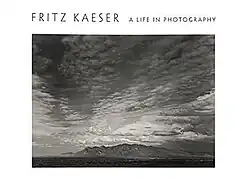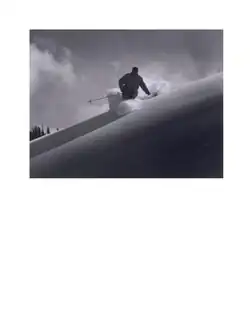Frederick Kaeser
Frederick "Fritz" Kaeser II (1910-1990) was an American photographer who worked in Madison, Wisconsin, Aspen, Colorado, and the American Southwest. He also did photography for the U. S. Army during World War II. Kaeser and his wife Milly established an endowment for photography at Notre Dame University.
Early life
Frederick Kaeser II was born on July 3, 1910 in Greenville, Illinois[1] to a family of Swiss background. His grandfather, Frederick Kaeser, was one the original investors, in 1885, in the Helvetia Milk Condensing Company in nearby Highland, Illinois, which was home to many immigrants from Switzerland and Germany. Frederick(I)'s son Albert was later also involved in the company. Frederick II studied at the University of Illinois (industrial arts), at the University of Wisconsin, and at the Art Institute of Chicago,[1] where he switched from art to photography.[2]
Professional Work

After college, Kaeser worked as an assistant to Hollywood, CA portrait photographer William Mortensen.[2] He then relocated to Madison, Wisconsin, where he opened a photographic studio.[1] While there, he contributed to several architecture books[3][4] and architectural journals for the pioneering firm of Beatty & Strang,[5] among others. (Kaeser's brother, William, was also an early modern architect in Madison, and designed a home there for Frederick II.)[6]

Raclin Murphy Museum of Art
(gift of Milly Kaeser)
Kaeser and his wife, Milly, built a summer home in Aspen, Colorado, and spent time there in the winter as well, where he became an early ski photographer. During World War II, Kaeser joined the 10th Mountain Division, based at Camp Hale, Colorado, and contributed to the division's newspaper.[2] After the war, he studied briefly with Ansel Adams. The Kaesers also built a house in Tucson, Arizona, where he "photograph[ed] natural textures and patterns found in the earth".[7] The Center for Creative Photography at the University of Arizona has a collection of Kaeser's work, equipment, papers and correspondence, including with Adams and Minor White.
Later life
"Fritz's Pet Milk inheritance enabled him to pursue a lifetime devoted to his hobbies."[2] In addition to photography, he was interested in rock collecting and polishing, setting up a studio in Arizona and a shop in Colorado. After Kaeser's death in 1990, his widow established the Fritz and Milly Kaeser Endowment for Photography at Notre Dame University's Snite Museum of Art (now Raclin Murphy Museum of Art),[8] as well as donating some pieces of Kaeser's work.[9]
References
- ^ a b c "Fritz Kaeser papers". Special Collections and Archives Department. Denver Public Library. Retrieved 13 March 2025.
- ^ a b c d Willoughby, Tim (28 July 2010). "Fritz Kaeser - Roch to rocks". The AspenTimes. Aspen Times Weekly. Retrieved 13 March 2025.
- ^ Abercrombie, Patrick (1939). The Book of the Modern House. London: Hodder & Stoughton. p. 303.
- ^ Beatty, Hamilton, and Allen Strang (1937). Speaking of Houses. Madison, Wisconsin: Democrat Printing Co.
{{cite book}}: CS1 maint: multiple names: authors list (link) - ^ Filipowicz, Diane (2025). Beatty and Strang, 1930-1941. Madison, WI: James Creek Press.
- ^ "3505 Blackhawk Drive, Shorewood Hills". Property Records. Wisconsin Historical Society. Retrieved 13 March 2025.
- ^ Swinford, Ashley. "Center for Creative Photography". College of Fine Arts. University of Arizona. Retrieved 13 March 2025.
- ^ "Raclin Murphy Museum of Art". Notre Dame University. Retrieved 13 March 2025.
- ^ "Fritz Kaeser". Marble. Notre Dame University. Retrieved 13 March 2025.
Further reading
- David Acton, A History of Photography at the University of Notre Dame, Vol. 2, London, D. Giles Ltd., 2019, pp. 236–39.
- Stephen R. Moriarty, Fritz Kaeser: A Life in Photography, 1998.